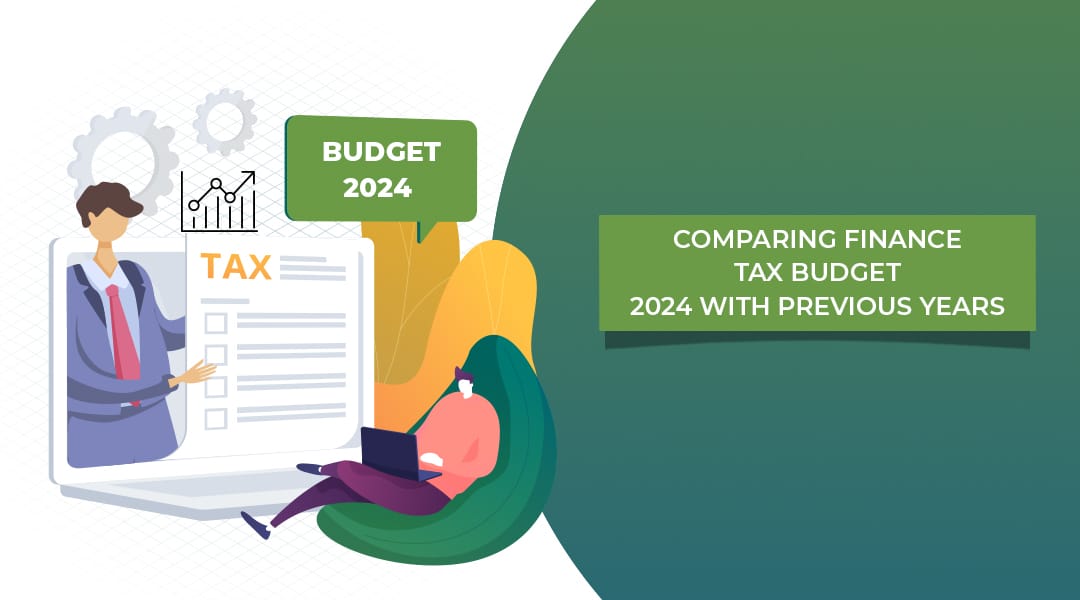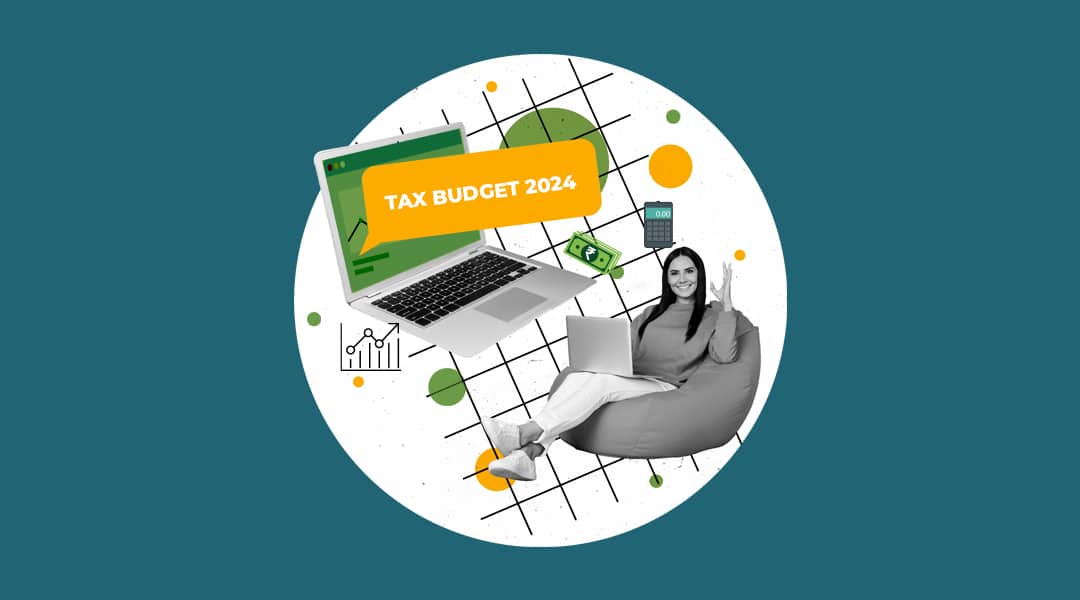The Finance Tax Budget 2024 is quite likely to be one of the most looked forward to announcements in recent times as this announcement has made several changes to the income tax slab. This budget has introduced a new way of treating personal taxation, which shows the government’s direction to ease compliance and spur the economy. These changes underline the government’s commitment to enhancing GDP growth and supporting the startup ecosystem through targeted taxation policies. In this blog, you will also find the key points of the budget comparison with the previous year and discover more details about the new tax system.
What is an Income Tax Slab
Income tax in India is paid according to the particular tax slab to which an individual belongs, depending on his income. These slabs set a number of income brackets, such that the closer an individual’s income is to a certain threshold, the higher the rate of tax to be paid. This slab system ensures equal and just taxation across the region, which is essential for infrastructure development and economic stability. Income tax slabs are generally updated during budget announcements and are categorized into three age-based groups:
- Individuals below 60 years,
- Senior citizens aged 60 to 80 years,
- Super senior citizens over 80 years.
Income Tax Slabs Under New Tax Regime for FY 2024-25
The new tax regime that was introduced in the 2024 Budget is relatively beneficial for small taxpayers as there are new tax slabs and an enhanced standard deduction. This move is part of broader tax reforms aimed at improving finance management services for individuals and businesses, particularly small and medium enterprises (SMEs). Finance Minister Nirmala Sitharaman announced the following key updates:
New tax reform for the salaried employees has been released, and the standard deduction for them has been set at ₹75,000. New tax relief for the family pensioners has also been released with an increase in the limit of the standard deduction at ₹25,000. This would help offer tax breaks to about 40 million employees who are paid salaries and pensioners.
What Are The Features of New Tax Regime
The new tax regime is now the default for calculating individual tax liability, with fewer deductions and exemptions compared to the old regime. Key features include:
- Five Income Tax Slabs: The tax schedule stands between 5% to 30% with the highest tax slab for incomes exceeding India rupees fifteen lacs.
- Basic Exemption Limit: Tax on income up to ₹10000 /- is nil, Nil tax up to ₹3 lakhs.
- Tax Rebate: For the sales income up to ₹7 lakh, the buyer is eligible for maximum rebate of ₹25,000 leading to zero sale tax.
- Standard Deduction: ₹. 50000/- For Salaried employees and Pensioners; ₹. 15000/- for family Pensioners.
- Surcharge on High Incomes: A flat surcharge of 25% of income exceeding ₹ 5 crore.
- Marginal Tax Relief: Some respite for those earners who have their income just above ₹7 lakh with a view to bring down their tax component.
Old vs. New Income Tax Slabs For FY 2023-24 (AY 2024-25)
A comparison of tax slabs between the old and new regimes under the Finance Budget 2024 reveals adjustments to enhance GDP growth and encourage employment initiatives.
| Tax Slab for FY 2023-24 (Old) | Tax Rate | Tax Slab for FY 2024-25 (New) | Tax Rate |
| Upto ₹3 lakh | Nil | Upto ₹3 lakh | Nil |
| ₹3 lakh – ₹6 lakh | 5% | ₹3 lakh – ₹7 lakh | 5% |
| ₹6 lakh – ₹9 lakh | 10% | ₹7 lakh – ₹10 lakh | 10% |
| ₹9 lakh – ₹12 lakh | 15% | ₹10 lakh – ₹12 lakh | 15% |
| ₹12 lakh – ₹15 lakh | 20% | ₹12 lakh – ₹15 lakh | 20% |
| More than ₹15 lakh | 30% | More than ₹15 lakh | 30% |
Source link – https://www.bajajfinserv.in/investments/income-tax-slabs
Old vs. New Income Tax Slabs For FY 2023-24 (AY 2024-25) for HUF and Individuals
| Annual Taxable Income | New Tax Regime | Old Tax Regime |
| Up to Rs.2.5 lakh | Exempt | Exempt |
| Over Rs.2.5 lakh to Rs.3 lakh | Exempt | 5% |
| Over Rs.3 lakh to Rs. 5 lakh | 5% | 5% |
| Over Rs.5 lakh to Rs.6 lakh | 5% | 20% |
| Over Rs.6 lakh to Rs. 9 lakh | 10% | 20% |
| Over Rs.9 lakh to Rs.10 lakh | 15% | 20% |
| Over Rs.10 lakh to Rs.12 lakh | 15% | 30% |
| Over Rs.12 lakh to Rs.15 lakh | 20% | 30% |
| Above Rs.15 lakh | 30% | 30% |
Source – https://www.maxlifeinsurance.com/blog/tax-savings/income-tax-slab-2023-24
Old vs. New Income Tax Slab for Super Senior Citizens For AY 2024-25 (FY 2023-24)
| Annual Taxable Income | New Tax Regime | Old Tax Regime |
| Up to Rs.3 lakh | Exempt | Exempt |
| Over Rs.3 lakh to Rs. 5 lakh | 5% | Exempt |
| Over Rs.5 lakh to Rs.6 lakh | 5% | 20% |
| Over Rs.6 lakh to Rs. 9 lakh | 10% | 20% |
| Over Rs.9 lakh to Rs.10 lakh | 15% | 20% |
| Over Rs.10 lakh to Rs.12 lakh | 15% | 30% |
| Over Rs.12 lakh to Rs.15 lakh | 20% | 30% |
| Above Rs.15 lakh | 30% | 30% |
Source – https://www.maxlifeinsurance.com/blog/tax-savings/income-tax-slab-2023-24
Old vs. New Income Tax Slabs & Rates for Senior Citizens For AY 2024-25 (FY 2023-24)
| Annual Taxable Income | New Tax Regime | Old Tax Regime |
| Up to Rs.3 lakh | Exempt | Exempt |
| Over Rs.3 lakh to Rs. 5 lakh | 5% | 5% |
| Over Rs.5 lakh to Rs.6 lakh | 5% | 20% |
| Over Rs.6 lakh to Rs. 9 lakh | 10% | 20% |
| Over Rs.9 lakh to Rs.10 lakh | 15% | 20% |
| Over Rs.10 lakh to Rs.12 lakh | 15% | 30% |
| Over Rs.12 lakh to Rs.15 lakh | 20% | 30% |
| Above Rs.15 lakh | 30% | 30% |
Source – https://www.maxlifeinsurance.com/blog/tax-savings/income-tax-slab-2023-24
Income Tax Slab for AOP, BOI & AJP in AY 2024-25
| Net Taxable Income | Income Tax Rate FY 2023-24 |
| Up to Rs. 2.5 lakh | Exempt |
| Over Rs. 2.5 lakh up to Rs. 5 lakh | 5% of income exceeding Rs. 2.5 lakh |
| Over Rs. 5 lakh up to Rs. 10 lakh | Rs. 12,500 + 20% of income exceeding Rs. 5 lakh |
| Over Rs. 10 lakh | Rs. 1,12,500 + 30% of income exceeding Rs. 10 lakh |
Source – https://www.maxlifeinsurance.com/blog/tax-savings/income-tax-slab-2023-24
Old vs. New Surcharge on Income Tax for FY 23-24
| Income | Surcharge Rate in Old Tax Regime | Surcharge Rate in New Tax Regime |
| Less than Rs.50 lakh | NIL | NIL |
| Rs.50 lakh – Rs.1 crore | 10% | 10% |
| Rs.1 crore – Rs.2 crore | 15% | 15% |
| Rs.2 crore – Rs.5 crore | 25% | 25% |
| Rs.5 crore – Rs.10 crore | 37% | 25% |
| More than Rs.10 crore | 37% | 25% |
Source – https://www.maxlifeinsurance.com/blog/tax-savings/income-tax-slab-2023-24
Condition for Opting For New Tax Regime
Taxpayers who choose the new regime must forgo certain deductions and exemptions available in the old regime, including:
- Leave Travel Allowance (LTA)
- Conveyance Allowance
- House Rent Allowance (HRA)
- Relocation Allowance
- Children’s Education Allowance
- Professional Tax
- Helper Allowance
- Deductions under Chapter VI-A (e.g., Sections 80C, 80D, 80E), except Section 80CCD(2)
- Standard Deduction on Salary
- Interest on Housing Loan (Section 24)
- Other Special Allowances (Section 10(14))
What Exemptions/Deductions are Available & Unavailable under the New Tax Regime
Among many features, the restriction of the range of exemptions and deductions is one of the key features of the new tax system. The rationale for this is to reduce tax computation as it erodes various exemptions and deductions that a taxpayer used to enjoy.
The 2020 budget removed about 70 of the 100 exemptions under the new tax regime. Opting for the 24-25 income tax brackets means giving up key exemptions and deductions, including:
- House Rent Allowance (HRA): No longer deductible for rented accommodation.
- Leave Travel Allowance (LTA): Travel expenses while on leave are no longer deductible.
- Specific Allowances: Exemptions for allowances like conveyance and children’s education are removed.
- Tax-Free Perquisites: Benefits such as food coupons are now taxable.
- Chapter VI A Deductions: Deductions like those under Section 80C (investments) and 80D (medical insurance) are unavailable.
- Home Loan Interest Deduction: No deduction for interest paid on self-occupied property.
Some deductions and exemptions remain, including:
- NPS Contributions by Employer: Deductible up to 10% of salary (14% for Central Government employees).
- Standard Deduction on Rental Income: 30% deduction on net rental income.
- Home Loan Interest: Deductible for the let-out property.
- Transport Allowance for Divyang Employees: Exempt for daily travel expenses.
- Conveyance Allowance: Allowed for official duties.
- Allowances for Travel and Transfer: Exempt for costs associated with work-related travel or transfer.
- Daily Allowance: Allows expenses while away from the normal place of duty.
Does this seem confusing? Then you might need a financial management consulting partner like GGC. They will help you in understanding the difference between the old and the new regime and guide you to opt for the best one of both.
Benefits and Drawbacks of New Tax Regime
Choosing between the new and old tax regimes depends on your financial habits, income, and investment strategy:
Benefits:
- Simplified Tax Process: A number of deductions ease the filing process.
- Reduced Tax Rates: Standard rates for those earning up ₹ 7 lakhs with possibilities to gain additional net income.
- Tax Rebate Advantage: These above provisions entail a full rebate for persons with an income of up to seven lakhs of rupees.
- Enhanced Liquidity: There are no compulsory investments in tax-saving instruments, so one is likely to have more cash at his or her disposal.
Drawbacks:
- Loss of Deductions: Missing key deductions (e.g., HRA, LTA) may increase taxable income.
- Reduced Financial Flexibility: Limited opportunities to lower taxes through investments.
- Higher Taxes for High Earners: Potentially higher taxes for incomes over ₹10 lakhs.
- Disadvantages for Long-Term Savers: Excludes benefits from tax-saving investments, impacting wealth accumulation.
Conclusion
The Finance Tax Budget 2024 has introduced significant changes to the income tax system, marking a shift towards a simplified and more transparent tax regime. With new tax slabs and increased standard deductions, the budget aims to provide relief to small taxpayers and streamline compliance. While the new regime offers reduced tax rates and simplified processes, it comes at the cost of losing various deductions and exemptions available in the old system. The choice between the old and new tax regimes will largely depend on individual financial situations and investment strategies. Understanding these changes can help taxpayers make informed decisions and optimize their tax benefits in the coming financial year.
FAQs
Can I switch between the old and new tax regimes?
Yes, taxpayers can choose between the old and new tax regimes. However, once the choice is made, it generally applies for the entire financial year.
How will the new tax regime benefit small taxpayers?
The new tax regime benefits small taxpayers by offering lower tax rates, an increased standard deduction, and a tax rebate for income up to ₹7 lakh.
How much income is tax free in India in 2024?
In the old tax regime, individuals under 60 years old are granted an exemption up to Rs. 2.5 lakhs, while senior citizens aged between 60 and 80 years enjoy an exemption up to Rs. 3 lakhs. Additionally, super senior citizens, aged above 80 years, are exempted up to Rs. 5 lakhs.
Is 7 lakh income tax-free?
In the old regime, individuals are exempt from tax if their taxable income (after deductions) is less than Rs. 5 lakh. Conversely, in the New Regime, the entire income remains tax-free if it falls below Rs. 7 lakh.



